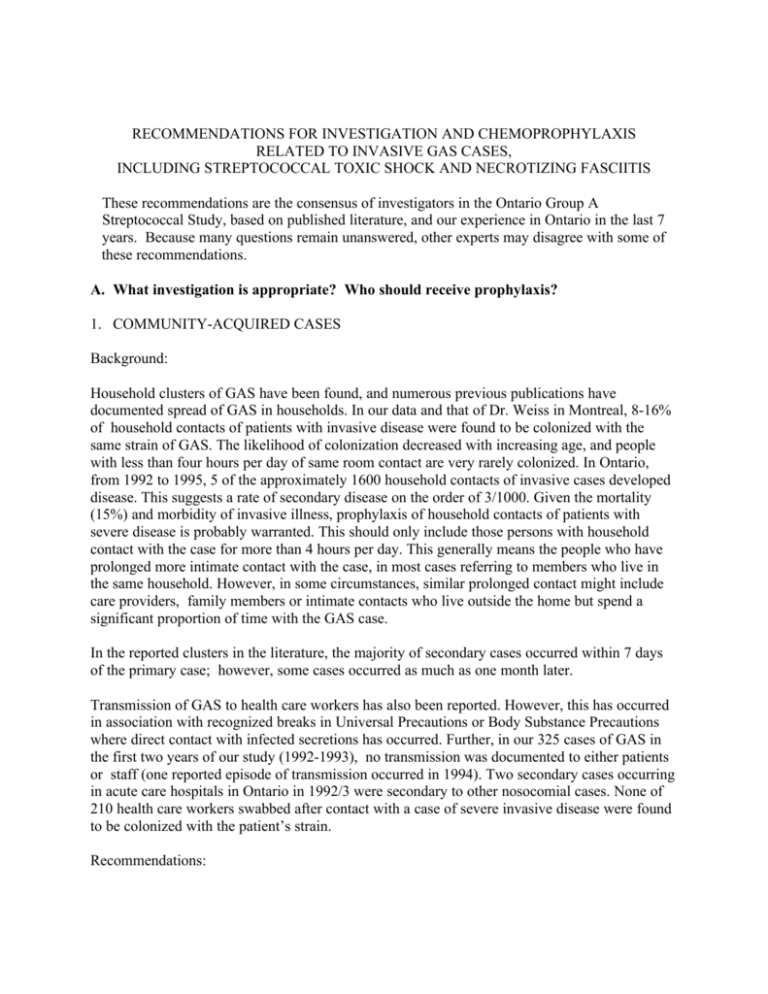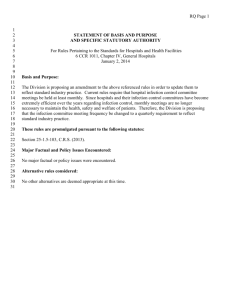recommendations for investigation and chemoprophylaxis related
advertisement

RECOMMENDATIONS FOR INVESTIGATION AND CHEMOPROPHYLAXIS RELATED TO INVASIVE GAS CASES, INCLUDING STREPTOCOCCAL TOXIC SHOCK AND NECROTIZING FASCIITIS These recommendations are the consensus of investigators in the Ontario Group A Streptococcal Study, based on published literature, and our experience in Ontario in the last 7 years. Because many questions remain unanswered, other experts may disagree with some of these recommendations. A. What investigation is appropriate? Who should receive prophylaxis? 1. COMMUNITY-ACQUIRED CASES Background: Household clusters of GAS have been found, and numerous previous publications have documented spread of GAS in households. In our data and that of Dr. Weiss in Montreal, 8-16% of household contacts of patients with invasive disease were found to be colonized with the same strain of GAS. The likelihood of colonization decreased with increasing age, and people with less than four hours per day of same room contact are very rarely colonized. In Ontario, from 1992 to 1995, 5 of the approximately 1600 household contacts of invasive cases developed disease. This suggests a rate of secondary disease on the order of 3/1000. Given the mortality (15%) and morbidity of invasive illness, prophylaxis of household contacts of patients with severe disease is probably warranted. This should only include those persons with household contact with the case for more than 4 hours per day. This generally means the people who have prolonged more intimate contact with the case, in most cases referring to members who live in the same household. However, in some circumstances, similar prolonged contact might include care providers, family members or intimate contacts who live outside the home but spend a significant proportion of time with the GAS case. In the reported clusters in the literature, the majority of secondary cases occurred within 7 days of the primary case; however, some cases occurred as much as one month later. Transmission of GAS to health care workers has also been reported. However, this has occurred in association with recognized breaks in Universal Precautions or Body Substance Precautions where direct contact with infected secretions has occurred. Further, in our 325 cases of GAS in the first two years of our study (1992-1993), no transmission was documented to either patients or staff (one reported episode of transmission occurred in 1994). Two secondary cases occurring in acute care hospitals in Ontario in 1992/3 were secondary to other nosocomial cases. None of 210 health care workers swabbed after contact with a case of severe invasive disease were found to be colonized with the patient’s strain. Recommendations: (i) Household contacts Offer prophylaxis to all household contacts who have: • regular contact (same room AND intermittent direct contact) for more than 4 hours per day, and had this contact in the week prior to the case patient becoming ill; or • have had direct mucous membrane contact in the week prior to case patient illness. If the case occurred more than 2 weeks prior, it is probably most reasonable to swab the contacts and treat those who are positive, rather than treating everyone, This will minimize antibiotic use, but still prevent on-going transmission of the strain. (ii) Patients/health care workers No prophylaxis is recommended for health care workers unless there have been breaks in aseptic precautions resulting in direct contact between secretions of patient and skin/mucous membranes of health care workers, Since, by the time the GAS is cultured, the patient will almost certainly have been on appropriate antibiotics for at least 24 hours, and the transmission risk will have been significantly reduced, isolation is not generally recommended. If invasive GAS infection is strongly suspected on admission, or the diagnosis is made prior to the initiation of antibiotic therapy, hospitals using UP and category-specific isolation might consider contact isolation until the patient has received 24 hours of effective antibiotic therapy. 2. NOSOCOMIAL CASES Background: Nosocomial outbreaks of GAS have been well-described. Any two cases of nosocomial GAS infection clearly require full outbreak investigation. The appropriate investigation of a single nosocomial case is not as clear cut: some cases of nosocomial infection may occur when a patient's own GAS strain causes the infection. However, in our investigations, 3/9 single nosocomial infections were associated with transmission of the strain to another patient or a health care worker or both. Recommendations: • Two nosocomial cases require immediate and full investigation. • A single nosocomial case warrants a limited investigation to assess the potential for secondary cases. Samples of such limited investigation follows: (i)Surgical site infection occurring within 4 days of surgery. Infection is likely either community acquired, or acquired during surgery. Recommended investigation: • review of community risk factors for case (children at home, exposure to daycare, contact with pharyngitis, cellulitis, invasive disease); • survey of OR staff involved in case - questionnaire regarding recent illness consistent with GAS (pharyngitis, cellulitis), and throat/skin lesion swabs (we do not recommend perineal/vaginal swabbing in the investigation of a single case); • heightened surveillance for nosocomial GAS infections on surgical services for one month. (ii)Nosocomial obstetrical infection Infection is often community-acquired; but may be transmitted person to person (in one outbreak, apparently associated with contamination of sitz-baths) or via colonized/infected delivery room staff. Because GAS may cause endometritis, which is not expected to have an etiologic diagnosis, and because of the early discharges of patients, care needs to be taken to ensure that potentially-associated infections are not missed. Recommended investigation: • review of community risk factors for case (children at home, exposure to daycare, contact with pharyngitis, cellulitis, invasive disease); consider swabbing children at home (if GAS positive, reduces the likelihood that nosocomial transmission has occurred). • survey of caseroom staff involved in case - questionnaire regarding recent illness consistent with GAS (pharyngitis, cellulitis), and throat/skin lesion swabs; • heightened surveillance for obstetrical GAS infections for next month. • consider swabbing roommate of case (throat, skin, vaginal discharge), all cases of endometritis (vaginal discharge for GAS screen), or infants at discharge if there are no community risk factors identifiable. (iii) Other nosocomial infections The risks of on-going transmission of such infections are less well described than surgical site or obstetrical infections. However, infection after long term carriage of GAS is probably rare. Thus, when an infection occurrs in a patient who has been in the hospital for more than 4-7 day, the oganism must have been imported. The investigation should be tailored to the specific infection, and should again include investigation of: • the likelihood that visitors or another patient introduced the strain; • questionnaires and swabbing of staff with direct contact with the patient (or involved in the direct care of the site of infection involved e.g. iv team for iv site infections); • other GAS or potential GAS nosocomial infections. 3. CASES ASSOCIATED,WITH INSTITUTIONS OTHER THAN ACUTE CARE HOSPITALS (e.g. nursing homes) Numerous outbreaks of GAS infection have been reported from nursing homes in recent years. Such outbreaks frequently invo1ve both residents and staff with both the site and severity of infection varying substantially within any one outbreak. We investigated 6/13 cases of nursing home acquired invasive GAS infections in Ontario in 1992/3. Of these, 5 were associated with an outbreak in the nursing home. In general, in such outbreaks, the strain is widespread within the facility, and investigation/prophylaxis only of close contacts is not the optimal approach. Recommendations: When a single institutional case is recognized, the facility should (i) Report the case to the Public Health Unit (ii) Review all microbiology reports for the last 2 months for GAS. • If any GAS isolates are found, move to step (v). • If no positive GAS isolates are found, move to Step (iii). (iii) Review the surveillance records for cellulitis or pharyngitis in the previous 4-6 weeks. • If greater than 4 incidents per 100 residents in one month, move to Step (v). • If less than 4 incidents per 100 residents in one month, then move to Step (iv). (iv) (v) Review all resident charts for cellulitis, paronychia (nail infection) or pharyngitis for the last 4-6 weeks, looking for minor skin infections that may have been missed by routine surveillance. • If greater than 4 incidents per 100 residents per month are found, an investigation should be started. • If no incidents are found, the investigation can be stopped. However, it is recommended that for the next 8 weeks, the LTCF maintain surveillance for cellulitis, paronychia and pharyngitis and ensure that swabs are taken from each infection when it occurs. If the LTCF has less then 100 beds, screen all residents by taking throat swabs and swabs of skin lesions. In LTCFs with greater than 100 beds, screen all residents in the same geographic areas the infected residents. In choosing the additional residents to be screened, start with residents who have some contact with the infected resident (i.e. Dining room, activities). • Staff should be questioned about recent infection and swabbed if any symptoms compatible with GAS infection are identified. • Inform your laboratory that a batch of swabs for GAS screening is being sent and that isolates should be saved. Indicate on requisition forms that “GAS screening only’ is being requested. • As part of the ongoing management of the GAS infection, all persons colonized with GAS must receive prophylaxis B. What Antibiotic should be used for prophylaxis? Background: There is little published data on the success rate of eradication of GAS carriage in household contacts. Our study looking at a short course (4 days) chemoprophylaxis with either Rifampin or Cefixime this purpose, showed that Rifampin is not efficacious (38% eradication rate immediately after therapy); and cefixime is probably inadequate at 77% after therapy and 52% at 10-14 days after therapy). Thus one is left with assuming that eradication rates will be similar in these people and in persons treated for pharyngitis. In people treated for pharyngitis, penicillin VK alone for 10 days has an eradication rate of 80-85% (occasionally as low as 65%). Thus, some experts believe that penicillin alone is not adequate. In general, cephalosporins appear somewhat more effective than penicillin VK.) Recommendations: When contacts are to receive prophylaxis, a 10 day course of either a cephalosporin (e.g. Keflex 250 mg QID) or erythromycin (250 mg QID in cephalosporin allergic patients) should be used. Penicillin VK (300 mg QID) may be used as an alternative. C. Identification and Treatment of Necrotizing Fasciitis and STSS Severe pain (sometimes without any skin abnormality), with either fever or an elevated white blood cell count should raise the suspicion of necrotizing fasciitis. If there is cellulititis, blistering of the skin strongly suggests that there is necrosis in deep tissues. Treatment of STSS with or without necrotizing fasciitis should include: 1. Penicillin 3 million units q4h IV (or a cephalosporin) AND clindamycin 900 mg IV q8h 2. IVIG - intravenous immunoglobulin - 2 gm/kg body weight as one dose (this is a very large dose - usually requires 2-3 liters of fluid) For further information on treatment see Guidelines for treatment of NF and STSS (link to K5a) During office hours, the Ontario Group A Streptococcal Study can be reached at 1-800-668-6292. This document has been prepared by Dr. A. McGeer for the Ontario Group A Streptococcal Study. It is intended as a guide to be used by health care professionals in managing investigations and contacts of invasive group A streptococcal disease. Professional opinion may vary on some aspects of these recommendations.






